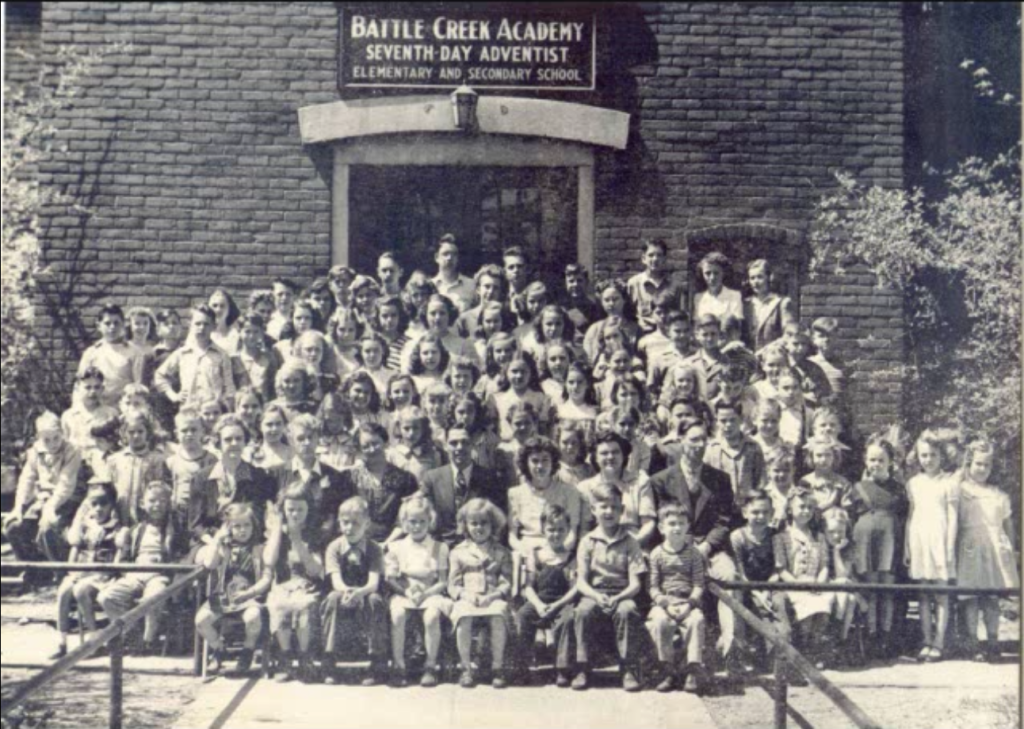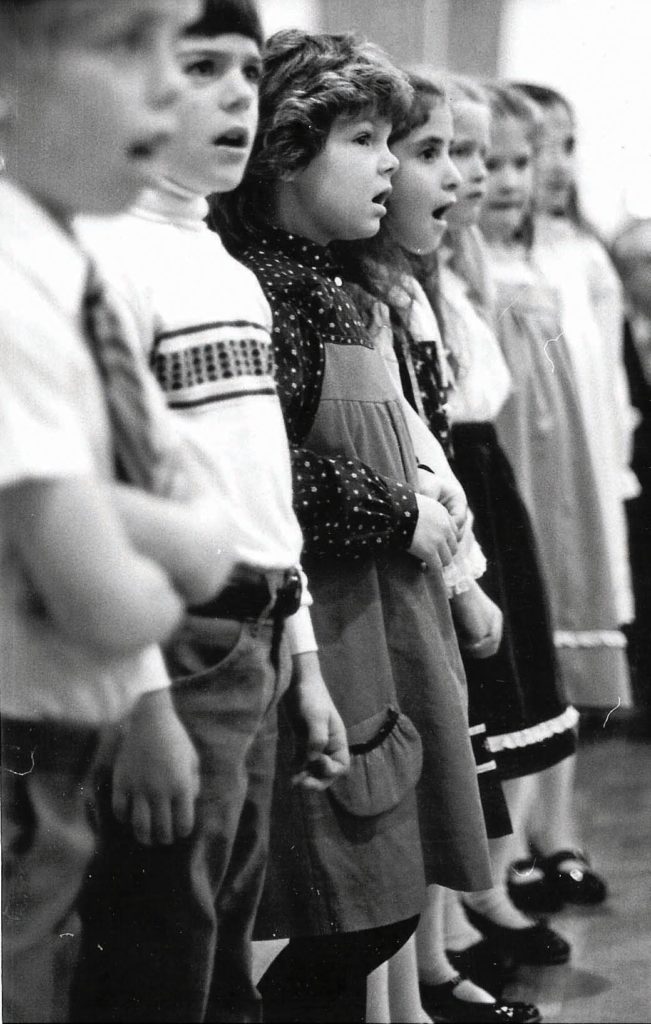Celebrating 149 Years of Adventist Education
Our History

In 1856, church member Mrs. Mary Osgood began operating a small school out of her home in the West End of Battle Creek.1 Mrs. Osgood received twenty-five cents for each student2 that attended classes in her home, and she was responsible for the instruction of all subjects. For the next few years this home school continued to operate with a succession of teachers.
In 1867, public school teacher Goodloe Harper Bell was recuperating at the Battle Creek Sanitarium when a group of Adventist boys discovered that he was a teacher. The young boys asked Bell if he would consider helping them with grammar, writing and arithmetic. Bell agreed, and soon found himself instructing twelve local students. Among these twelve were the sons of James & Ellen White –– James Edson White and William Clarence White, as well as two other well-known names, John Harvey Kellogg and William Keith Kellogg.3
Mr. Bell had a saying: “A thing worth doing is worth doing well.”4 His students quickly learned to appreciate his efforts to help them understand their lessons. In fact, they were so impressed with his clarity and thoroughness that they begged their parents to get Mr. Bell to start a school.
After some consideration, the parents hired Mr. Bell to begin instructing their children and they provided him with a classroom in the old North Lodge. This room had become “a dumping place for cast-off materials”5 from the Review office, but with a little “cleaning and refurnishing it became the location for Bell’s Select School.”6 Mary Alice Steward, one of Bell’s students remembered the “Select School” as being
“…old and rickety and unpainted. The schoolroom was on the second floor, so we climbed the shaky stairs, and found ourselves entering a long low room, with long wooden benches for seats. In the center of the room at one side, facing the door, was the teacher’s desk, and the classes assembled on benches in front of it.”7
Professor Bell believed that instruction in his “Select School” must coincide with his newly found Adventist faith. When textbooks containing suitable material were not available, Bell hand-wrote the lessons for his students. If young people were unable to attend his school because they had to work during the day, he began provided early morning and night classes.

For five years he persevered. Goodloe Harper Bell was convinced that quality Adventist Education was needed and he played a crucial role in establishing the first successful Adventist school.9
At the end of those five years, Bell’s reputation for conscientious teaching had spread and the enrollment at his school had increased dramatically. As a result, the General Conference of Seventh-day Adventists heeded the request of Adventists in Battle Creek and took this special school under its wing.
On June 3, 1872, Battle Creek Academy opened as the first Seventh-day Adventist denominationally sponsored school and included both an elementary and secondary program.10 The school was housed in the old print shop at the Review and Herald Publishing House. On that first day of classes, Professor Bell stood at the door and greeted his students as they arrived with their paper and writing utensils.
However, for the pioneers of Adventist education, a church supported school on the premises of the Publishing House was just a stepping stone. As the Academy continued to grow, finding sufficient space to accommodate all the students in the Review and Herald building became challenging–especially with the later establishment of Battle Creek College.
Then in 1901, Battle Creek College moved to Berrien Springs, Michigan and is today known as Andrews University.11 Nonetheless, church leaders were convinced that the Adventist young people in the Battle Creek area still needed the opportunity to have a Christian Education. With this in mind, they determined to construct a building with adequate classrooms and learning space.
On September 3, 1903, “ground was broken for a S. D. A. school building.”12 One year later, a brand new Academy opened on North Kendall Street. This three-story building housed a number of classrooms and provided its five faculty members with sufficient space to teach all the essentials of a quality Christian Education.
For over forty years Battle Creek Academy operated from this building. Many of the academy’s alumni fondly recall attending classes at this location. Then on April 11, 1945, a consuming fire sounded the doom of the school on Kendall Street. The Battle Creek Enquirer and News stated that:
Battle Creek Academy, the Seventh-day Adventist school on North Kendall street was extensively damaged by fire early this morning and was closed to its 222 students.
School principal V. E. Garber canceled classes for the remainder of the week but stated that classes would soon resume either on the premises in areas not damaged by the fire or “in other buildings, several of which are available.”13
When it became evident that the state fire marshal’s office was going to condemn the building due to extensive damage from the fire, smoke and water, dedicated parents, students and friends wondered how they would ever recover from the loss of their beloved school.
For a time, classes were held in an old building near the Kellogg Field airport. But to those concerned for Adventist young people, it would take much more than a fire to quell their vision for Adventist Education. Planning began.
Members of the church established a committee and launched an appeal for funds to construct “a completely modern school for classrooms from elementary through high school grades and also a social hall.”14
On August 29, 1948, the Battle Creek Enquirer and News announced “a dream will be realized September 9 with the opening of school in the new Battle Creek Academy building at 180 Welch Avenue.” This contemporary Battle Creek Academy, built on forty-three acres of land, was a $225,000 unit that housed the most modern facilities and had approximately 1,500 window lights ensuring excellent visibility. The new facility also utilized solar radiation and “oil-burner steam heat with forced draft ventilation and humidity control.”15 Superintendent M. Dale Hannah and a faculty of fourteen provided students with a curriculum including French, English, science, history, math, industrial arts, accounting, secretarial and domestic sciences, music, printing and physical therapy.
Since 1948, the city of Battle Creek has renamed Welch Avenue to Parkway Drive. Accordingly, the academy’s address is now 480 Parkway Drive but the building housing the current academy is that which was built in 1948. Through the years, several modifications and additions (including the gymnasium, chapel, and band room) have been made to the building to ensure that the rich tradition of Adventist education continues in Battle Creek. For many years, Battle Creek Academy has enjoyed a strong heritage of excellence in music education. Over the years they have had the opportunity to serve their community through involvement in projects such as the Battle Creek Paint Blitz, Senior Citizen’s Banquet, Habitat for Humanity, the Christmas party for underprivileged children, the South Michigan Food Bank, leaf raking, hurricane cleanup efforts, and mission trips.
With the closing of the Battle Creek Sanitarium in the late 1970s, the Adventist population in Battle Creek began to diminish. We are now serving a large percentage of local and immigrant students who have made Battle Creek their home. This demographic change at the academy has shifted our paradigm to a mission school approach that demands a higher level of monetary support from its constituents and donors.
When Goodloe Harper Bell began his educational ministry, he sought to develop a practical, balanced program founded on Bible teachings that would nurture students’ physical, mental, and spiritual growth. Our caring and highly qualified teachers continually seek to provide a safe, nurturing, Christ-centered Seventh-day Adventist educational program that promotes excellence in our students’ spiritual, academic, physical, and social development to prepare them for service in this world and in the world to come. To continue this mission, we are striving to broaden our donor base, and we ask you to prayerfully consider becoming part of our donor pool and supporting us systematically with your financial gifts. With your help, we can continue to reach students for Christ until His soon return!
For more information about becoming a valued donor, please visit the giving page at battlecreekacademy.com/donate or call us at 269-965-1278.
Endnotes
1 Allan G. Lindsay, Goodloe Harper Bell Pioneer Seventh-Day Adventist Christian Educator, Abstract June 1982 (James White. Library, Andrews University)
2 SDA Encyclopedia, Vol. 10, p. 109, (Review and Herald Publishing Association: Washington DC, 1966)
3 Emmett K. Vandevere, The Wisdom Seekers p. 16 (Southern Publishing Association, Nashville, TN 1972)
4 George R. Knight, Early Adventist Educators p. 50 (Andrews University Press, Berrien Springs, MI)
5 Allan G. Lindsay, Goodloe Harper Bell Pioneer Seventh-Day Adventist Christian Educator, p. 51, (Abstract June 1982)
6 Allan G. Lindsay, Goodloe Harper Bell Pioneer Seventh-Day Adventist Christian Educator, p. 57, (Abstract June 1982)
7 Allan G. Lindsay, Goodloe Harper Bell Pioneer Seventh-Day Adventist Christian Educator, p. 57, (Abstract June 1982)
8 Allan G. Lindsay, Goodloe Harper Bell Pioneer Seventh-Day Adventist Christian Educator, p. 47 (Abstract June 1982)
9 Allan G. Lindsay, Goodloe Harper Bell Pioneer Seventh-Day Adventist Christian Educator, p. 54, (Abstract June 1982)
10 Walton J. Brown, Chronology of Seventh-day Adventist Education p. 8, (Department of Education, General Conference of Seventh-day -Adventists)
11 Walton J. Brown, Chronology of Seventh-day Adventist Education p. 9, (Department of Education, General Conference of Seventh-day Adventists)
12 The Enquirer and News, Sept. 3, 1903
13 The Enquirer and News, Wed., April 11, 1945
14 The Enquirer and News, Sun., August 29, 1948